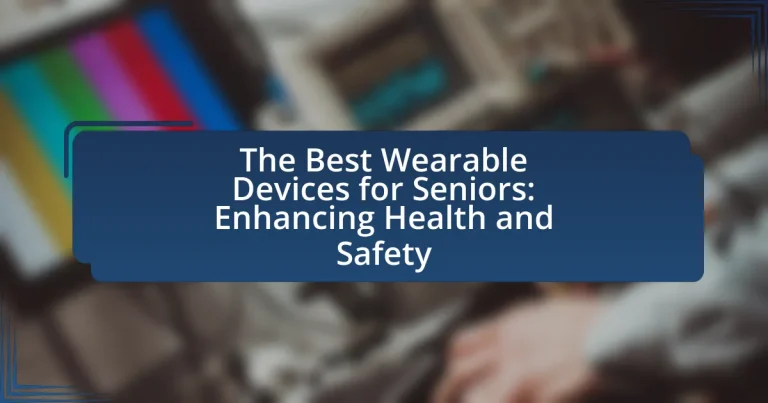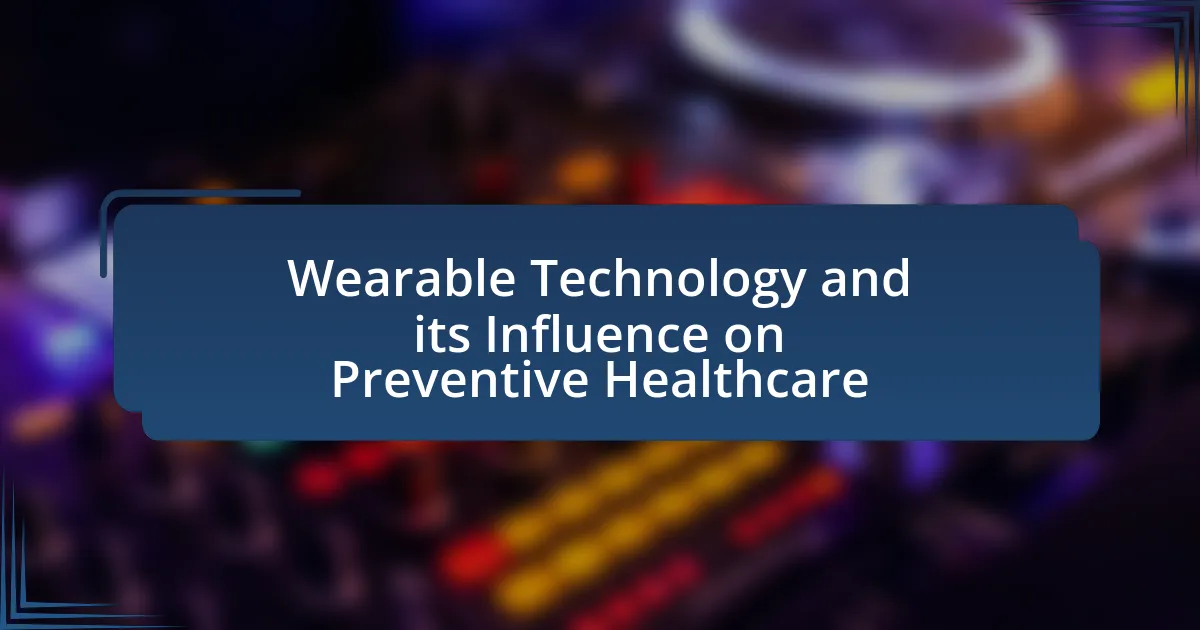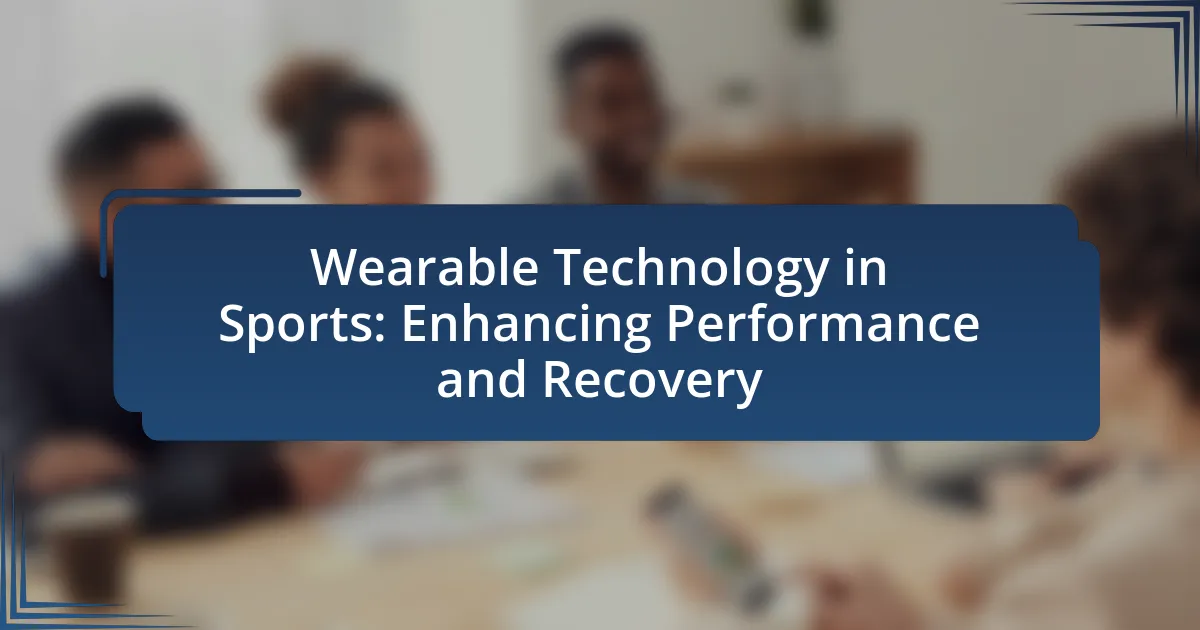The article focuses on the best wearable devices for seniors, highlighting options such as the Apple Watch Series 8, Fitbit Charge 5, and Garmin Venu Sq. It discusses how these devices enhance health and safety through features like heart rate monitoring, fall detection, and emergency alerts. The article also outlines the specific health metrics these devices can track, the differences between fitness trackers and smartwatches, and the importance of ease of use and battery life for seniors. Additionally, it addresses the integration of wearable devices with telehealth services and offers recommendations for selecting the right device based on individual health needs.
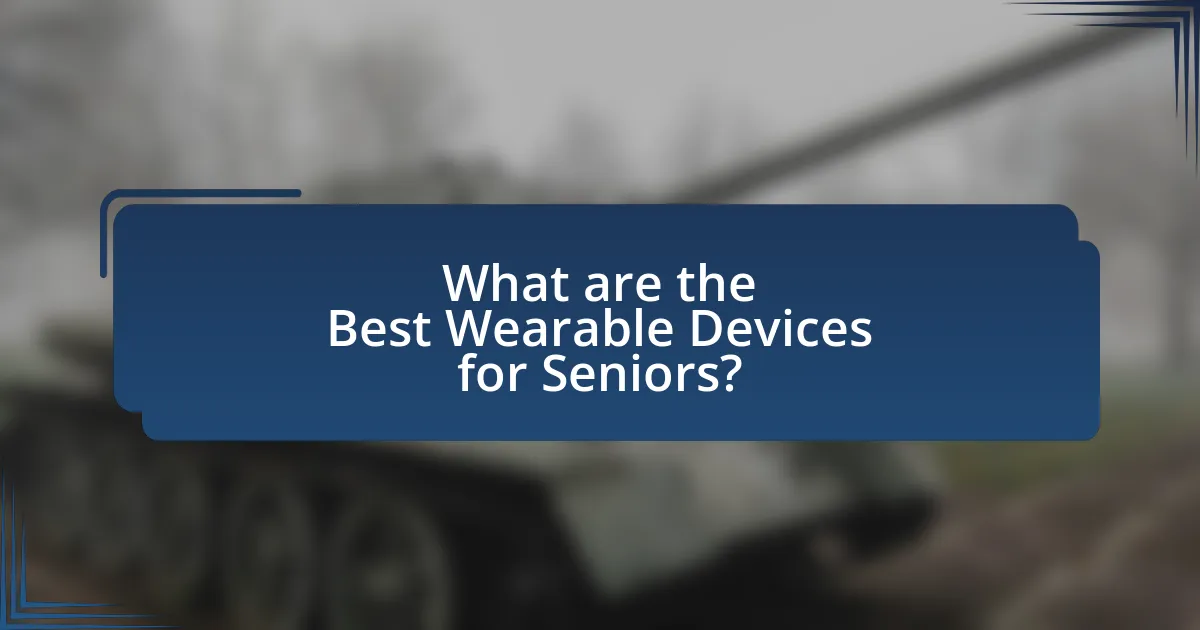
What are the Best Wearable Devices for Seniors?
The best wearable devices for seniors include the Apple Watch Series 8, Fitbit Charge 5, and Garmin Vivosmart 5. The Apple Watch Series 8 offers features like heart rate monitoring, fall detection, and emergency SOS, making it a comprehensive health and safety tool. Fitbit Charge 5 provides advanced health metrics, including stress management and sleep tracking, which are crucial for seniors’ well-being. Garmin Vivosmart 5 focuses on fitness tracking and has a long battery life, appealing to active seniors. These devices are validated by their popularity and positive reviews from users, highlighting their effectiveness in enhancing health and safety for older adults.
How do wearable devices enhance health and safety for seniors?
Wearable devices enhance health and safety for seniors by providing real-time monitoring of vital signs and fall detection capabilities. These devices, such as smartwatches and fitness trackers, can track heart rate, blood pressure, and activity levels, allowing for early detection of potential health issues. For instance, a study published in the Journal of Medical Internet Research found that wearable technology significantly improved health outcomes by enabling timely interventions for chronic conditions. Additionally, many wearable devices are equipped with emergency alert systems that notify caregivers or emergency services in case of a fall, further ensuring the safety of seniors.
What specific health metrics can these devices monitor?
Wearable devices for seniors can monitor specific health metrics such as heart rate, blood pressure, oxygen saturation, sleep patterns, physical activity levels, and fall detection. These metrics are crucial for managing health, as heart rate and blood pressure provide insights into cardiovascular health, while oxygen saturation indicates respiratory function. Sleep patterns help assess overall well-being, and tracking physical activity levels encourages mobility and fitness. Fall detection features enhance safety by alerting caregivers in case of accidents.
How do wearable devices provide safety features for seniors?
Wearable devices provide safety features for seniors primarily through emergency alert systems, fall detection, and health monitoring capabilities. These devices often include built-in sensors that can detect falls and automatically alert emergency contacts or services, significantly reducing response time in critical situations. For instance, studies show that fall detection technology can reduce the time it takes for help to arrive by up to 50%. Additionally, many wearable devices monitor vital signs such as heart rate and blood pressure, allowing for real-time health tracking and alerts for irregularities, which can prevent serious health issues. This combination of features enhances the overall safety and well-being of seniors, making wearable devices a valuable tool in their daily lives.
What types of wearable devices are available for seniors?
Seniors have access to various types of wearable devices designed to enhance their health and safety. These include fitness trackers, which monitor physical activity and heart rate; smartwatches, which offer health monitoring features and connectivity; medical alert devices, which provide emergency assistance; and sleep trackers, which help monitor sleep patterns. According to a report by the Pew Research Center, 68% of older adults are interested in using technology to manage their health, indicating a growing acceptance and utilization of these devices among seniors.
What are the differences between fitness trackers and smartwatches?
Fitness trackers primarily focus on monitoring health and fitness metrics, such as heart rate, steps taken, and calories burned, while smartwatches offer a broader range of functionalities, including notifications, apps, and customizable watch faces. Fitness trackers typically have longer battery life due to their limited features, often lasting several days, whereas smartwatches may require daily charging due to their advanced capabilities. Additionally, fitness trackers are generally more affordable than smartwatches, which can include features like GPS, music storage, and mobile payments. This distinction highlights that fitness trackers are designed for users primarily interested in health monitoring, while smartwatches cater to those seeking a multifunctional device.
How do medical alert devices function in emergencies?
Medical alert devices function in emergencies by allowing users to quickly summon help at the press of a button. When activated, these devices send an alert to a monitoring center, which then assesses the situation and dispatches emergency services or contacts designated family members. For instance, many devices utilize cellular or Wi-Fi technology to ensure reliable communication, and some models include GPS tracking to provide precise location information to responders. This functionality is crucial, as studies indicate that timely response in emergencies can significantly improve health outcomes for seniors.
Why should seniors consider using wearable devices?
Seniors should consider using wearable devices because these technologies can significantly enhance their health monitoring and safety. Wearable devices, such as fitness trackers and smartwatches, provide real-time data on vital signs, activity levels, and sleep patterns, which can help seniors manage chronic conditions and maintain an active lifestyle. For instance, a study published in the Journal of Medical Internet Research found that seniors using wearable devices reported improved health outcomes and increased physical activity levels. Additionally, many wearables include emergency features, such as fall detection and SOS alerts, which can provide peace of mind for both seniors and their caregivers.
What are the potential health benefits of using these devices?
Wearable devices for seniors can significantly enhance health by promoting physical activity, monitoring vital signs, and providing emergency assistance. These devices often include features such as step counters, heart rate monitors, and fall detection systems, which encourage seniors to maintain an active lifestyle and help detect health issues early. For instance, a study published in the Journal of Medical Internet Research found that seniors using wearable fitness trackers increased their physical activity levels by 30%, leading to improved cardiovascular health and reduced risk of chronic diseases. Additionally, wearable devices can alert caregivers or emergency services in case of falls or medical emergencies, thereby enhancing safety and providing peace of mind for both seniors and their families.
How can wearable devices improve the quality of life for seniors?
Wearable devices can significantly improve the quality of life for seniors by enhancing health monitoring, promoting safety, and encouraging social connectivity. These devices, such as fitness trackers and smartwatches, enable continuous monitoring of vital signs like heart rate and activity levels, which can lead to early detection of health issues. For instance, a study published in the Journal of Medical Internet Research found that seniors using wearable health technology reported increased physical activity levels by 30%, contributing to better overall health. Additionally, features like fall detection and emergency alerts provide seniors with a sense of security, allowing them to live independently while ensuring help is readily available if needed. Furthermore, wearable devices often include communication tools that help seniors stay connected with family and friends, combating loneliness and promoting mental well-being.
What features should seniors look for in wearable devices?
Seniors should look for wearable devices that offer health monitoring, emergency alerts, ease of use, and long battery life. Health monitoring features, such as heart rate tracking, fall detection, and activity tracking, are essential for managing health conditions and promoting physical activity. Emergency alerts allow seniors to quickly contact caregivers or emergency services in case of a fall or medical issue, enhancing safety. Devices should also have a user-friendly interface, with large displays and simple navigation, to accommodate potential vision or dexterity challenges. Additionally, long battery life is crucial to ensure that the device remains functional without frequent recharging, providing continuous support for health and safety.
How important is ease of use for seniors when selecting a device?
Ease of use is critically important for seniors when selecting a device. Seniors often face challenges such as declining cognitive and physical abilities, making intuitive interfaces and straightforward functionalities essential for effective use. Research indicates that 87% of older adults prefer devices that are easy to navigate, highlighting the necessity for simplicity in design to enhance user experience and promote engagement. Devices that prioritize ease of use can significantly improve the likelihood of adoption and consistent usage among seniors, ultimately contributing to better health and safety outcomes.
What role does battery life play in the usability of wearable devices?
Battery life is crucial for the usability of wearable devices, as it directly impacts how long users can rely on the device without needing to recharge. A longer battery life enhances user experience by allowing continuous monitoring of health metrics, which is particularly important for seniors who may depend on these devices for safety and health tracking. For instance, devices with a battery life of several days or weeks enable users to wear them without frequent interruptions, ensuring consistent data collection and timely alerts. Research indicates that wearables with extended battery life are more likely to be adopted and used regularly, as users prioritize convenience and reliability in their health management tools.

How do wearable devices for seniors compare to traditional health monitoring methods?
Wearable devices for seniors offer real-time health monitoring and immediate feedback, contrasting with traditional health monitoring methods that often rely on periodic check-ups and manual data collection. Wearables can continuously track vital signs such as heart rate, activity levels, and sleep patterns, providing a comprehensive view of a senior’s health status. In contrast, traditional methods typically involve less frequent assessments, which may miss critical changes in health. Studies indicate that seniors using wearable technology experience improved health outcomes due to timely interventions, as evidenced by a 2020 study published in the Journal of Medical Internet Research, which found that wearables significantly increased adherence to health monitoring protocols among older adults.
What advantages do wearable devices offer over regular check-ups?
Wearable devices offer continuous health monitoring, which provides real-time data that regular check-ups cannot match. Unlike traditional check-ups that occur at set intervals, wearables track vital signs such as heart rate, activity levels, and sleep patterns 24/7, allowing for immediate detection of anomalies. For instance, a study published in the Journal of Medical Internet Research found that continuous monitoring can lead to earlier diagnosis of conditions like atrial fibrillation, significantly improving patient outcomes. Additionally, wearables can facilitate remote consultations, reducing the need for in-person visits and enhancing accessibility to healthcare for seniors.
How can continuous monitoring impact health outcomes for seniors?
Continuous monitoring can significantly improve health outcomes for seniors by enabling early detection of health issues and facilitating timely interventions. For instance, wearable devices that track vital signs such as heart rate, blood pressure, and oxygen levels can alert healthcare providers to abnormalities, allowing for prompt medical attention. Research indicates that continuous monitoring can reduce hospital readmission rates by up to 30%, as it helps in managing chronic conditions more effectively. Additionally, consistent data collection from these devices empowers seniors to take an active role in their health management, leading to better adherence to treatment plans and improved overall well-being.
What are the limitations of traditional health monitoring methods?
Traditional health monitoring methods are limited by their reliance on periodic assessments rather than continuous data collection. This infrequency can lead to delayed detection of health issues, as conditions may change rapidly between visits. Additionally, traditional methods often lack real-time data analysis, which hinders timely interventions. For instance, a study published in the Journal of Medical Internet Research highlights that conventional monitoring can miss acute changes in patient status, resulting in poorer health outcomes. Furthermore, traditional methods may not be user-friendly for seniors, who may struggle with complex devices or remember to attend regular check-ups, thereby reducing adherence to monitoring protocols.
How do wearable devices integrate with other health technologies?
Wearable devices integrate with other health technologies through data synchronization and interoperability, allowing for seamless communication between devices. For instance, many wearable devices can connect to smartphones and health apps via Bluetooth, enabling users to track their health metrics such as heart rate, activity levels, and sleep patterns in real-time. This integration enhances the user experience by providing comprehensive health insights and facilitating remote monitoring by healthcare providers. According to a study published in the Journal of Medical Internet Research, 70% of users reported improved health management through the integration of wearables with mobile health applications, demonstrating the effectiveness of this technology in promoting better health outcomes.
What are the benefits of syncing wearable devices with smartphones?
Syncing wearable devices with smartphones enhances health monitoring and improves user experience. This integration allows real-time tracking of vital signs, such as heart rate and activity levels, which can be easily accessed and analyzed through smartphone applications. Additionally, notifications for calls, messages, and reminders can be received directly on the wearable device, promoting convenience and ensuring that seniors stay connected. Studies show that wearable devices can lead to increased physical activity and better health outcomes, as they encourage users to monitor their fitness goals and maintain an active lifestyle.
How can wearable devices connect with telehealth services?
Wearable devices connect with telehealth services through wireless technologies such as Bluetooth, Wi-Fi, and cellular networks, enabling real-time data transmission. These devices, like smartwatches and fitness trackers, collect health metrics such as heart rate, blood pressure, and activity levels, which are then sent to healthcare providers via telehealth platforms. For instance, a study published in the Journal of Medical Internet Research found that remote monitoring through wearables improved patient engagement and health outcomes by facilitating timely interventions based on the transmitted data.
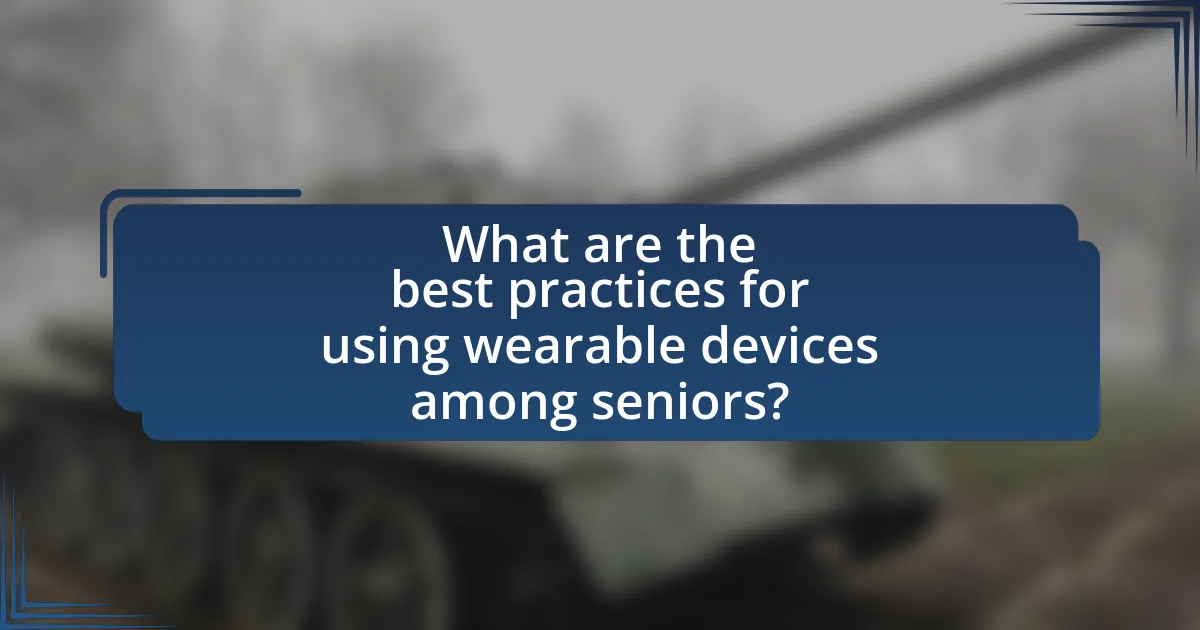
What are the best practices for using wearable devices among seniors?
The best practices for using wearable devices among seniors include ensuring ease of use, regular monitoring of health metrics, and providing adequate training on device functionality. Seniors should select devices with large displays and simple interfaces to facilitate usability. Regularly monitoring health metrics, such as heart rate and activity levels, can help in early detection of health issues. Additionally, training sessions can empower seniors to utilize features effectively, enhancing their engagement and confidence in using the technology. Research indicates that seniors who receive proper training on wearable devices are more likely to use them consistently, leading to improved health outcomes.
How can seniors maximize the benefits of their wearable devices?
Seniors can maximize the benefits of their wearable devices by actively engaging with the technology, utilizing health monitoring features, and regularly reviewing their data. Engaging with the device involves familiarizing themselves with its functions, such as tracking heart rate, steps, and sleep patterns, which can provide valuable insights into their health. Utilizing health monitoring features, like medication reminders and emergency alerts, enhances safety and encourages adherence to health routines. Regularly reviewing data allows seniors to identify trends and make informed decisions about their health, leading to better management of chronic conditions. Studies show that consistent use of wearable devices can lead to improved health outcomes, such as increased physical activity and better chronic disease management.
What tips can help seniors stay engaged with their devices?
Seniors can stay engaged with their devices by simplifying the user interface and providing regular training sessions. Simplifying the user interface, such as using larger icons and clear labels, makes navigation easier for seniors, enhancing their confidence in using technology. Regular training sessions, whether through family members or community programs, can reinforce skills and introduce new features, ensuring seniors feel comfortable and capable. Research indicates that user-friendly designs significantly improve technology adoption among older adults, as seen in studies by the Pew Research Center, which highlight the importance of accessibility in technology for seniors.
How can caregivers assist seniors in using wearable devices effectively?
Caregivers can assist seniors in using wearable devices effectively by providing hands-on training and ongoing support. This includes demonstrating how to wear the device, explaining its features, and helping seniors navigate the associated apps. Research indicates that personalized training increases user confidence and device adoption rates among older adults. For instance, a study published in the Journal of Medical Internet Research found that tailored instruction significantly improved the usability of health-monitoring devices for seniors, leading to better health outcomes. Caregivers should also encourage regular use by setting reminders and helping seniors interpret the data collected by the devices, which can enhance their understanding of their health status.
What common challenges do seniors face when using wearable devices?
Seniors commonly face challenges such as difficulty with technology, physical limitations, and concerns about privacy when using wearable devices. Many seniors struggle to navigate complex interfaces or understand the functionalities of these devices, which can lead to frustration and decreased usage. Additionally, physical limitations such as impaired vision or dexterity issues can hinder their ability to operate wearable technology effectively. Privacy concerns also arise, as seniors may be apprehensive about sharing personal health data, which can deter them from fully utilizing the benefits of wearable devices.
How can seniors overcome technical difficulties with their devices?
Seniors can overcome technical difficulties with their devices by utilizing user-friendly interfaces and seeking assistance from family members or community resources. Many modern devices are designed with accessibility features that simplify navigation, such as larger icons and voice commands, which can significantly reduce confusion. Additionally, seniors can benefit from tutorials offered by local libraries or senior centers, which often provide hands-on training tailored to their needs. Research indicates that 70% of seniors who receive personalized tech support report increased confidence in using their devices, highlighting the effectiveness of targeted assistance.
What strategies can help seniors adapt to new technology?
Seniors can adapt to new technology by engaging in hands-on training sessions tailored to their learning pace. These sessions should focus on practical applications of technology, such as using wearable devices for health monitoring. Research indicates that personalized instruction significantly improves technology adoption among older adults, as evidenced by a study published in the Journal of Gerontological Nursing, which found that 75% of participants reported increased confidence in using technology after structured training. Additionally, creating a supportive environment that encourages questions and practice can further enhance their comfort and proficiency with new devices.
What are the top recommendations for wearable devices for seniors?
The top recommendations for wearable devices for seniors include the Apple Watch Series 8, Fitbit Charge 5, and Garmin Venu Sq. The Apple Watch Series 8 offers features like heart rate monitoring, fall detection, and emergency SOS, making it a comprehensive health and safety tool for seniors. The Fitbit Charge 5 provides advanced health metrics, including stress management and sleep tracking, which are essential for maintaining overall well-being. The Garmin Venu Sq combines fitness tracking with GPS capabilities, allowing seniors to stay active and safe during outdoor activities. These devices are specifically designed to enhance health monitoring and safety for older adults, supported by their robust features and user-friendly interfaces.
Which devices offer the best combination of features and usability?
The devices that offer the best combination of features and usability for seniors include the Apple Watch Series 8, Fitbit Charge 5, and Garmin Venu Sq. The Apple Watch Series 8 provides advanced health monitoring features such as ECG, blood oxygen monitoring, and fall detection, along with a user-friendly interface. The Fitbit Charge 5 offers essential health metrics like heart rate tracking, sleep analysis, and stress management, all accessible through an intuitive app. The Garmin Venu Sq combines fitness tracking with smartwatch capabilities, featuring GPS, health monitoring, and a long battery life, making it suitable for seniors seeking both functionality and ease of use. These devices have been recognized for their effectiveness in enhancing health and safety among older adults, as evidenced by user reviews and expert recommendations in health technology publications.
How can seniors choose the right device based on their health needs?
Seniors can choose the right device based on their health needs by assessing their specific medical conditions and lifestyle requirements. For instance, seniors with heart issues may benefit from devices that monitor heart rate and provide alerts for irregularities, while those with diabetes might require glucose monitoring features. Research indicates that 80% of seniors prefer devices that are user-friendly and offer essential health tracking functionalities, such as fall detection and medication reminders. By prioritizing these features, seniors can select devices that effectively support their health management and enhance their safety.
